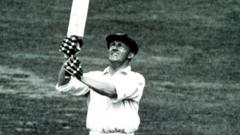India’s inaugural Test tour to Australia in 1947-48 nearly fell apart due to the violence and upheaval caused by the partition, yet it marked the beginning of an iconic rivalry in cricket history.
The Backstory of India's Historic Test Tour to Australia

The Backstory of India's Historic Test Tour to Australia
The challenges faced by the Indian cricket team before their first official Test series against Australia amid national turmoil.
In 1947, India found itself in the throes of turbulence following independence and the partition that carved the nation into India and Pakistan. Under these challenging circumstances, the Indian cricket team readied itself for its first official Test series against the legendary Australian side led by Don Bradman. The backdrop of national strife not only shaped the political landscape but also influenced the team dynamic.
The Board of Control for Cricket in India announced a 16-member squad amid a broken nation, celebrating a team that represented "undivided India." Previously, the Indian team had only toured England for Test matches, enduring defeat each time. An unofficial series with an Australian Services team in 1946 had heightened hopes, as India won 1-0, prompting Australian cricket officials to support a formal series against India.
As excitement built, key players withdrew due to personal and medical issues. Captain Vijay Merchant, deputy Mushtaq Ali, and others were unable to tour, leading to Lala Amarnath stepping up as captain. His path to Australia was fraught with danger; during a train journey, he narrowly escaped a sectarian mob in Punjab. A police official recognized him and provided him a steel kada— a symbol of faith— which likely saved his life. Meanwhile, pace bowler Fazal Mahmood was threatened on a train journey, prompting him to ultimately remain in Pakistan, impacting team composition.
Despite the team suffering substantial losses of key players, the tour commenced. India faced a historically great Australian team and fell in the series 4-0. The spirit of competition blossomed despite the grim realities back home. Today, over seven decades later, the rivalry continues as both nations meet frequently on the cricket field, a testament to the resilience of the sport and its players.
Gulu Ezekiel, author of several sports books, brings this historic narrative to light as a reminder of the extraordinary circumstances surrounding this pivotal moment in cricket history.
The Board of Control for Cricket in India announced a 16-member squad amid a broken nation, celebrating a team that represented "undivided India." Previously, the Indian team had only toured England for Test matches, enduring defeat each time. An unofficial series with an Australian Services team in 1946 had heightened hopes, as India won 1-0, prompting Australian cricket officials to support a formal series against India.
As excitement built, key players withdrew due to personal and medical issues. Captain Vijay Merchant, deputy Mushtaq Ali, and others were unable to tour, leading to Lala Amarnath stepping up as captain. His path to Australia was fraught with danger; during a train journey, he narrowly escaped a sectarian mob in Punjab. A police official recognized him and provided him a steel kada— a symbol of faith— which likely saved his life. Meanwhile, pace bowler Fazal Mahmood was threatened on a train journey, prompting him to ultimately remain in Pakistan, impacting team composition.
Despite the team suffering substantial losses of key players, the tour commenced. India faced a historically great Australian team and fell in the series 4-0. The spirit of competition blossomed despite the grim realities back home. Today, over seven decades later, the rivalry continues as both nations meet frequently on the cricket field, a testament to the resilience of the sport and its players.
Gulu Ezekiel, author of several sports books, brings this historic narrative to light as a reminder of the extraordinary circumstances surrounding this pivotal moment in cricket history.




















